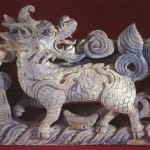Yuan Terracotta Relief Sculpture Depicting a Qilin, 1279 CE - 1368 CE
Terracotta
16.25
H.528
The Yuan Dynasty was established by Kublai Khan, the grandson of Genghis Khan, upon relocating the capital of his empire from Mongolia to Beijing. The Forbidden City was constructed, a...
The Yuan Dynasty was established by Kublai Khan, the grandson of Genghis Khan, upon relocating the capital of his empire from Mongolia to Beijing. The Forbidden City was constructed, a relative oasis of Mongolian culture in the heart of China. While the Mongol elite retained their native language and customs, they did adapt the Chinese system of bureaucratic government and cemented the authoritarian rule of the emperor. Although they were unaffected by Chinese culture, the Yuan did little to stifle the native traditions and beliefs of their subjects. Buddhism continued to flourish, although the monasteries received little funding from the state. In fact, during the Yuan Dynasty, China first began to open up to foreigners. Christian and Hindu missionaries were established in Beijing and Marco Polo made his famous journey during the Yuan era. While the Chinese never accepted the Yuan as a legitimate dynasty, instead viewing them as foreign bandits, the Mongolians rebelled against the Beijing Khans for becoming, “too Chinese.” In the end, the Yuan Dynasty had the shortest duration of the major Chinese Dynasties, lasting little more than a hundred years.
In this Yuan relief, a mythical animal called a qili (unicorn) frolics in a pasture composed of clouds, conch shells, and shrubs. Usually pictured alone, the unicorn is said to attain the age of on thousand years, and to be the noblest form of animal creation, the emblem o perfect goodness. It is regarded a a happy portent, on its alleged appearance, of the advent of good government o the birth of virtuous rulers. Th unicorn envelops itself with benevolence, and crowns itself with rectitude. A fabulous creature of good omen, and the symbol o longevity, grandeur, felicity, illustrious offspring, and wise administration,
the qilin became a popular motif in court clothing of high-ranking officials,
paintings, chinaware and architectural reliefs.
This representation of a qilin reflects the common myt and lore regarding its appearance and adheres to iconographic standards fo depicting a qilin. Because it footsteps bring good to those who cross over them, the qilin is pictured i light stride, all fours blessing the ground it touches, never inflicting harm t the grass or insects it encounters. Surrounde by either fire or clouds, it is also pictured with its head turned back an mouth wide open, from which the sound of bells and other musical instruments ca be heard. The qilin possesses al the good qualities that are to be found among all hairy animals such as a kin disposition, discriminating mind, and brightly colored skin. It resembles a stag in its general form but combines the body of the mus deer with the tail of an ox, the forehead of a wolf, the hoofs of a horse, and soft-tipped horn emblematic of its unique, gentle nature. The auspicious nature of the qilin emanates from this relief sculptur that is sure to inject positive energy into its surroundings.
In this Yuan relief, a mythical animal called a qili (unicorn) frolics in a pasture composed of clouds, conch shells, and shrubs. Usually pictured alone, the unicorn is said to attain the age of on thousand years, and to be the noblest form of animal creation, the emblem o perfect goodness. It is regarded a a happy portent, on its alleged appearance, of the advent of good government o the birth of virtuous rulers. Th unicorn envelops itself with benevolence, and crowns itself with rectitude. A fabulous creature of good omen, and the symbol o longevity, grandeur, felicity, illustrious offspring, and wise administration,
the qilin became a popular motif in court clothing of high-ranking officials,
paintings, chinaware and architectural reliefs.
This representation of a qilin reflects the common myt and lore regarding its appearance and adheres to iconographic standards fo depicting a qilin. Because it footsteps bring good to those who cross over them, the qilin is pictured i light stride, all fours blessing the ground it touches, never inflicting harm t the grass or insects it encounters. Surrounde by either fire or clouds, it is also pictured with its head turned back an mouth wide open, from which the sound of bells and other musical instruments ca be heard. The qilin possesses al the good qualities that are to be found among all hairy animals such as a kin disposition, discriminating mind, and brightly colored skin. It resembles a stag in its general form but combines the body of the mus deer with the tail of an ox, the forehead of a wolf, the hoofs of a horse, and soft-tipped horn emblematic of its unique, gentle nature. The auspicious nature of the qilin emanates from this relief sculptur that is sure to inject positive energy into its surroundings.
Literature
V17



